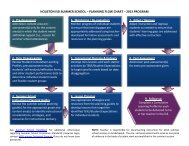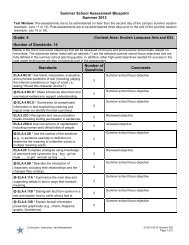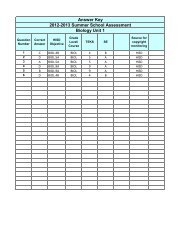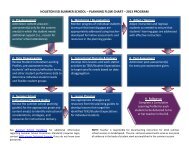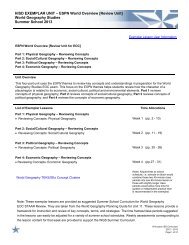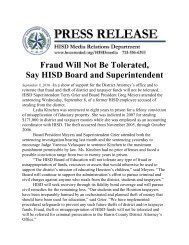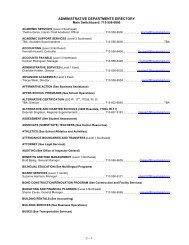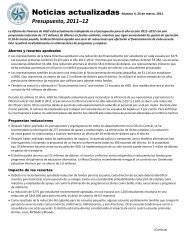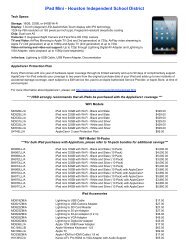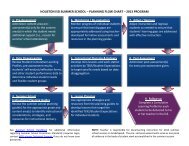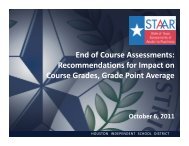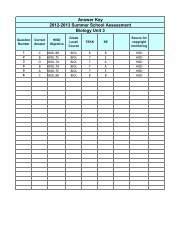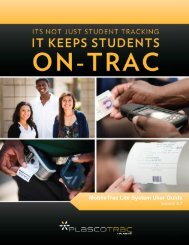SSK Unit 4.2 Planning Guide
SSK Unit 4.2 Planning Guide
SSK Unit 4.2 Planning Guide
- No tags were found...
You also want an ePaper? Increase the reach of your titles
YUMPU automatically turns print PDFs into web optimized ePapers that Google loves.
Instructional ConsiderationsHISD PLANNING GUIDEEnglish Language Arts Grade 7SUMMER SCHOOLBackground Knowledge for TeacherReview terms throughout the unit. Have students create Vocabulary Notebooks to record terms throughout summerschool. Utilize Marzano’s Six-Step Process for vocabulary retention and use Think-Alouds to model vocabularyintegration and use of strategies. See ELA Best Practices MS in Resources.Review the various types of context clues and give examples of each: Definition/Description Classification Compare/Contrast Prior experience Example Cause/EffectModel the use of context clues by voicing thought processes with a Think-Aloud. See ELA Best Practices MS and BestPractices Toolkit in Resources. (ELA.7.2B)ReadingInstructional Accommodations for Diverse Learners Build ELLs’ speaking skills and academic vocabulary use by incorporating Think-Pair-Shares andTiered Response Stems. These help lower affective filters and provide opportunities for ELLs to work withpeers in a non-threatening environment. See Seidlitz’s Navigating the ELPS in the English Language Artsand Reading Classroom in Resources. (ELPS C.2d)PrerequisitesStudents should have prior knowledge related to comprehension of narrative text structures.Background Knowledge for TeacherThis unit builds knowledge of narrative structures and elements through the study of fictional short stories. SeeLiterature Grade 7 in Resources for a list of suggested texts.Remind students to preview texts, make predictions, and set purposes for reading before beginning to read selectedtexts. Review predicting and have students continually form predictions as they read. Use mentor texts to modelconnecting, predicting, visualizing, and questioning a text through Think-Alouds. This method illustrates the processgood readers go through as they read. Be sure to use cues where appropriate. See Best Practices Toolkit inResources. (ELA.7.Fig19A)Have students record their thoughts and notes on their reading in a Literacy Notebook. Literacy Notebooks are used tocollect information and monitor reading comprehension. See ELA Best Practices MS in Resources.Instructional Accommodations for Diverse Learners Provide opportunities for ELLs to practice speaking using correct English sentence structures andconnecting words. Provide sentence stems such as “I don’t understand what/how…” and “So you’resaying…” to encourage students to seek clarification. See Seidlitz’s Navigating the ELPS in the EnglishLanguage Arts and Reading Classroom in Resources. (ELPS C.2d)Review the 3 levels of reading:• Reading on the line- basic comprehension (who, what, when, where)• Reading between the lines- interpreting a text• Reading beyond the lines- creating universal meaning of a textSee Laying the Foundation: <strong>Planning</strong> <strong>Guide</strong> for Pre-AP English Grade Seven in Resources.Emphasize that authors write for a specific reason. Review author’s purpose and illustrate the link between reader’spurpose and author’s purpose. Explain that although fiction is usually meant to entertain, there is often an underlyingtheme that adds depth. Encourage students to read texts with a corresponding deeper purpose.Review the elements of fiction. Show students how these elements connect and interact in order to develop the plot of a - English Language Proficiency Standards (ELPS) - Literacy Leads the Way Best Practices - Aligned to Upcoming State Readiness Standard- State Process Standard R - State Readiness Standard S - State Supporting Standard© Houston ISD Curriculum2012 – 2013Page 3 of 8




